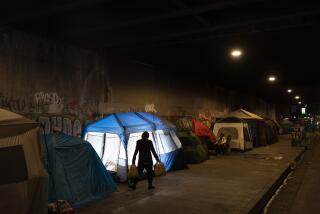Selling an ‘Image’ of Homelessness to the Charitable
- Share via
You’ve probably seen them before. Every year, from October to Christmas, the Los Angeles Mission places photographs of old, white men in newspaper ads around the city and encourages us to help them. If you haven’t spotted them in newspapers, you’ve undoubtedly spied their faces on one of those huge billboards.
They are faces that tug at our heartstrings, engender our sympathy and get us to dole out money.
They are supposed to be the faces of homelessness.
But they’re not, not really. My colleagues at the newspaper know it. So do the thousands of other people who work Downtown or anybody else who has been around homeless shelters. The people at the Los Angeles Mission know it all too well.
They know that the face of homelessness is black, it’s brown, it’s female, it’s children and it’s young. Those are the people who make up the majority of the thousands of people who annually walk through their doors, who eat the 450,000 meals they serve annually, who crowd their drug rehabilitation programs and job training classes.
But those aren’t the faces that we want to see. Those apparently aren’t the people we want to feed, the people to whom we want to give our money. And the people at the Los Angeles Mission know that too.
“Sex is an issue, race is an issue and ethnicity is an issue in terms of the type of support that is provided,” said Jennifer Sanchez, an account executive at the marketing and public relations firm that works with the Los Angeles Mission.
So, in order to serve the “truly needy” (a term coined by Ronald Reagan, the man most responsible for their plight in the first place), the Mission provides these images on ads so we can feel comfortable about contributing our money.
“The pictures are a reflection of what people view the homeless as, which may not necessarily be reality,” Sanchez said.
Oh, don’t blame the people at the Mission. It’s not that they’re trying to be deceitful. Their problem is that they have decided to feed, house, clothe and minister to the homeless, regardless of race, creed, color, gender or age. So, they need to get the money the best way they can--even if that means using a marketing ploy.
In all honesty, the folks at the Mission have tried to show us the diverse faces of homelessness. Every year, in an effort to make their campaign more successful, they test different photographs to see which ones are most “effective” in garnering donations.
By now, they’ve got it down to a science. They can almost tell you which photograph on which day at which place in the newspaper will bring what results.
In recent years, they’ve tested photographs of women and children, blacks, Latinos and young people to see the public’s response. And here’s what they found:
Photographs of homeless men work better than those of women (which is a problem, since women and children make up 20% of the homeless and are the fastest growing segment of the homeless population.)
“Intuitively in my mind, women on the streets, especially those with children, seem to be most compelling of all the stories,” said Sanchez. “It’s hard for me to understand why those who give to the homeless aren’t coming from that same perspective.”
Pictures of young men don’t work well either, even though the average age of the homeless population now is 28, not the late 50s or early 60s as portrayed in the seasonal fund-raising ads.
“People have written in and said, ‘This guy doesn’t look homeless. He looks healthy,’ ” explained Giff Clayborne, the man who oversees and began the Mission’s advertising campaign. “They don’t realize that the guy has been smashed out of his mind for three years on drugs, just got out of prison or can’t really read or write. There’s a lot that has to be done before this guy is employable.”
Photographs of blacks and Latinos, who make up 85% of the homeless Downtown, rank consistently at the bottom. They work best if the person has white hair. Clayborne says there is a theory that photographs of blacks and Latinos don’t reproduce well in the ad. “You lose all of the detail in the face, and you don’t get the same impact in terms of facial projection toward the person looking at the photograph.”
Maybe so, but I have a different theory.
Last year, at the prodding of the chaplains to present a face more representative of the population they serve, the mission used more photographs of blacks, Latinos and women in their ads. Contributions were down by 20%. Clayborne attributes part of the reason for the decline to the public distraction in an election year, although he admits the pictures had something to do with it.
The mission does make a lot of efforts to educate the public on the changing face of homelessness, and Clayborne says he’d love to actually use a difference face every day.
“But we have to ask ourselves a question just in terms of stewardship,” Clayborne said. “Can we afford to use those photos and recognize that we might be less successful and attract less people to the ongoing support of the Mission? Is that the most responsible thing to do?”
They have apparently decided no. This year, the Mission has pretty much confined its newspaper ad campaign to six photographs, all but one of aging white men.
“Unfortunately, we’re forced into that position because of the public perception and the public response,” Clayborne said. “It doesn’t make it right. It doesn’t make it wrong either. It makes it what it is.”
More to Read
Sign up for Essential California
The most important California stories and recommendations in your inbox every morning.
You may occasionally receive promotional content from the Los Angeles Times.






